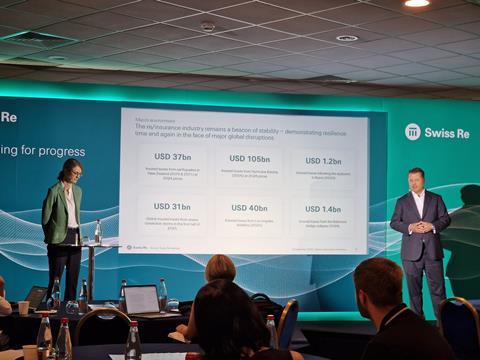At RVS 2025 in Monte Carlo, Swiss Re executives highlighted nuclear energy investment, rising civil unrest exposures and geopolitical volatility as prominent features of the evolving risk landscape.

Swiss Re executives used their RVS 2025 briefing to emphasise the reinsurance industry as a beacon of stability and resilience.
Urs Baertschi, chief executive of property and casualty reinsurance, said the reinsurance industry was operating in “a very dynamic environment” shaped by shifting trade policy and geopolitical volatility.
He warned that disruption to supply chains and labour markets could raise claims costs.
“There’s no economic activity without insurance,” Baertschi said.
“Insurance and reinsurance play a stabilising factor and an enabling element to trade, to manufacturing, to innovation, to technology, wherever you look. And this is where the opportunity is.”
Nuclear growth potential
Gianfranco Lot, chief underwriting officer of property and casualty reinsurance, pointed to nuclear energy as a growth area for insurers.
He noted projections that global nuclear output could triple by 2050, in line with a pledge at COP28, with significant investment planned in the United States, China and parts of Europe.
Lot stressed that Swiss Re, which runs the Swiss nuclear pool, was preparing for both large-scale new facilities and the arrival of smaller modular reactors.
“The tripling of nuclear energy means that more nuclear plants will be built,” he said. “Some will be recommissioned, and there’s a political discourse in many countries where sentiment is changing around nuclear. New technologies are safer, cleaner, more modular and more transportable.”
He added that while containerised mini-reactors were still in development, Swiss Re was assessing the potential underwriting challenges, including transport and storage risks.
“Clearly it’s a novel technology, and as with all new technology, we still have a lot of questions,” Lot said.
SRCC and geopolitical volatility
Baertschi warned of the increasing frequency of civil unrest worldwide, insured as strikes, riots and civil commotion (SRCC) within property business.
“We’ve talked about the increased risk of people going to the streets, for riots, for unrest, for civil commotion,” he said.
“This is something we’re seeing on the rise globally, and it is a concern. At the end of the day, somebody has to pay for those damages.”
Lot added that accumulation management was vital to avoid excessive concentration of SRCC exposure, particularly as litigation trends and social inflation further complicate the liability environment.
Swiss Re’s executives tied SRCC to broader geopolitical pressures, from tariffs and trade policies to energy security and war.
Baertschi argued that while these risks created uncertainty, they also underscored the industry’s societal role.
“In all of this, insurance and reinsurance enable economic production and growth, as well as protection of society,” he said.
“That’s how we see the opportunity, regardless of the external environment.”










No comments yet